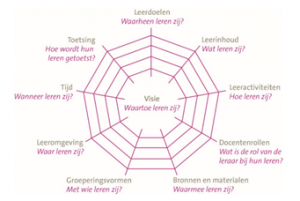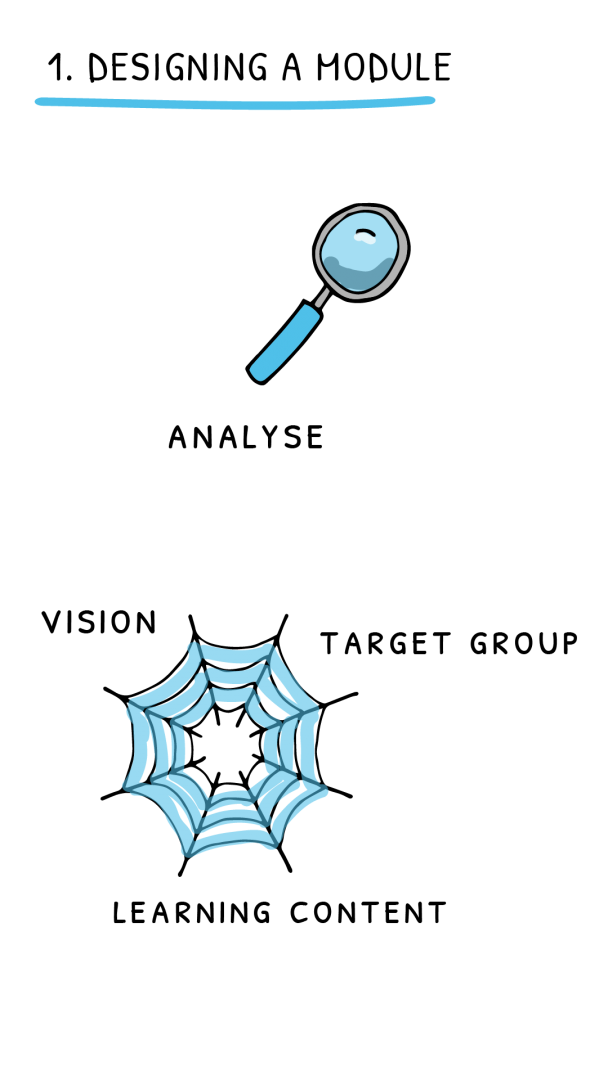Designing a module
Quality education does not happen by chance – just like other types of product development, it involves a design process. Designing the education you offer provides you with a trajectory and framework for its development and implementation.
Why?
Designing education is an iterative process that follows an established system. This method offers the best guarantee for quality education: students learn what they need. They receive education that fits the curriculum and the target group and is practical to implement.
What?
Module design involves three steps:
1. Identifying a vision and principles
It is important to have a foundation before starting development! What is your view of learning and blended learning? What is the underlying foundation behind your teaching approach?
The principles of your module consist of:
- the rationale or underpinning: why this module forms part of the curriculum;
- vision on education;
- vision on testing;
- description of the target group;
- vision on the lecturer’s role.
Van den Akker’s curriculum spiderweb (2003) (NL) shows which elements form part of an educational design.

- underpinning or rationale;
- learning outcomes and learning objectives;
- learning content;
- learning activities;
- lecturer’s role;
- sources and material (also online);
- target group and types of group;
- learning environment (offline and online);time;
- assessment.
Collect the principles by requesting them from your team leader or your programme manager, or by discussing them with the team. The principles are important for analysing your module.
At More – Educational models, you will find educational models and information about blended learning at FDMCI.
2. Analysis of the module
A careful analysis of the module is important for ensuring a good design: how will it fit into the curriculum, what is the target group, etc. Record your analysis so it will be clear afterwards how the design came about. The analysis will provide information about:
- the rationale;
- the learning content;
- the target group;
- the lecturer’s role;
- the time.
Formulate answers to the following questions – these may be described in the professional framework.
- Rationale: Why is this module being offered?
- Analysis of the principles underpinning the degree programme: Within which framework is the module being developed?
- What is the vision of the lecturer’s role?
Coach, inspirer, subject-matter expert, pedagogic, didactic, etc.? - What is the didactic vision, or the vision of learning, or the vision of the educational concept?
(constructivism, cognitivism, differentiation, personalised and flexible learning, project-based learning, PBL) - What is the vision of assessment?
- What is the vision of the lecturer’s role?
- Target group analysis: who is your student?
Full-time or part-time, admissions level, age, degree programme, other student characteristics - What is the context of the module? What are the situational factors?
Consider: place within the programme, ECTS credits, prior knowledge lecturer population, whether it is a course that students get stuck on?- On which level is the module being offered?
- Which module or modules should this module be able to fit in with, and which modules will possibly follow it?
- Analysis of the knowledge base
- What is the course content; which decisions are being made with regard to it?
- Which exit qualifications, learning outcomes or competences does this module work towards?
- Which components of the Body of Knowledge and Skills (BOKS) does this module cover?
On the basis of this analysis, you will fully or partially describe the following elements of the curriculum spiderweb: 1. the rationale, 3. the learning content, 5. the lecturer’s role, 7. the target group and 9. the time for your module.
Discuss your analysis with your team and also involve students in the discussion.
3. Designing your module
On the basis of the analysis, you can start designing the module. The programme or faculty will often have methods and models for this. A clear design will guide the development of teaching content, including for other lecturers.
The design must in any case include:
- the whys and wherefores of the module: a substantiation of its importance and its place in the curriculum. This is at the core of the design;
- the module’s learning content, based on the BOKS and related to the content of previous and future modules;
- the lecturer’s role, based on the programme’s vision of education;
- the target group: student characteristics;
- the time, based on the number of ECTS credits. How to distribute the study time will be addressed when developing learning activities and structuring the learning environment.
This will give you a sound framework within which to develop the module. Before developing your educational activities, first pay attention to designing learning outcomes and ways of testing these. In other words, you start by designing the tail end!
On the basis of your analysis you can describe some aspects of your design; these will guide the other design aspects.

Constructive alignment as described in Teaching for quality learning at university: what the student does. (Biggs & Tang, 2011)
How?
There are various educational design methods. The programme may already have settled on one. Such methods include the following:

